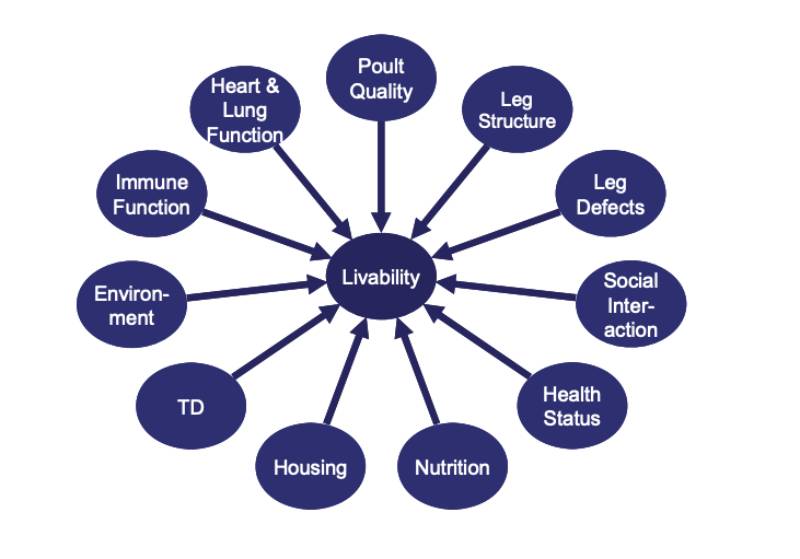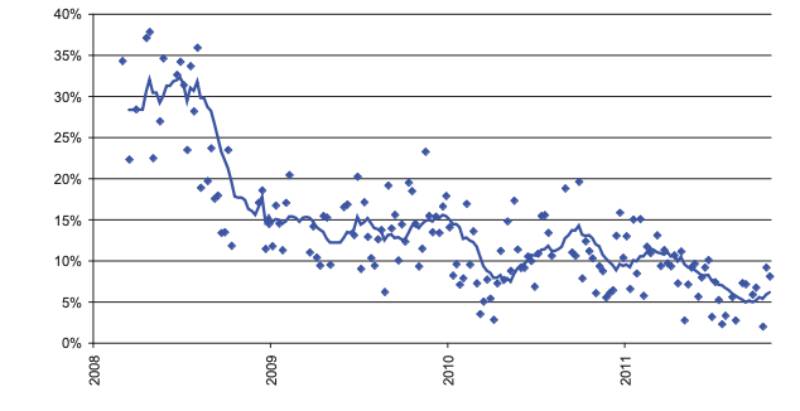Introduction
The role of the primary breeder is to supply turkeys that perform with the highest levels of biological performance and health status. To achieve this, modern turkey breeding uses a broad selection objective including a range of health, fitness, efficiency, reproduction and meat traits. Care is taken to make sustainable and predictable year-on-year progress in all traits, to satisfy the requirements determined by our customers and society as a whole. The primary breeder performs selection at the pedigree level, and then transmits the genetic progress through multiplication steps, i.e. great-grandparent and grand-parent level. The grand-parents produce the cross-bred parent stock. The parent stock male and female lines are then mated together to produce the commercial male and female turkeys. The time-line from pedigree level to commercial bird is approximately 4 years (Graph 1). One of the most important assets for any breeder is having a large and diverse gene pool. This allows new line combinations and crosses to be developed to respond to changing requirements. Care is taken to preserve genetic variation by avoiding inbreeding in the populations. Aviagen Turkeys’ gene pool includes a total of approximately 40 different turkey pure lines, which are of 14 different colour variants, suitable for both indoor rearing and for extensive outdoor rearing. The observed bird performance results from a combination of genetics, stockmanship, housing, nutrition and health factors. It is only the genetic component, explaining typically 10% to 30% of the observed variation, which can be utilised to permanently improve a breed. However, the stockmanship, housing, nutrition and health factors, explaining the majority of variation, are extremely important considerations (diagram 2). The primary breeders provide an extensive range of continually-updated technical and management recommendations to its customers and their farmers in order to enhance welfare and optimise performance further. This paper describes the development of welfare traits in the Aviagen Turkey breeding programmes.Balanced Breeding
Aviagen Turkeys operates a balanced breeding programme where health, fitness, welfare and production traits are taken into consideration. To achieve this balance a high number of traits (>30) are measured on individual pedigree turkeys, and when the final selection of pedigree birds are made for the next generation, the selection decision is made on information from both the individual itself and the information from up to 250,000 relatives. When performing balanced selection, traits that are either favourably or unfavourably correlated to each other are being selected for simultaneously. An example of an unfavourable correlation would be live weight and egg production, where heavier birds tend to lay a lower number of eggs. Similar adverse relationships can exist between production and health traits.Diagram 1 Diversity of breeding stock, multiplication pyramid and feedback mechanism of
Aviagen Turkey breeding programme. GGP = Great Grandparent Stock

Diagram 2 Relative impact of genetics and management factors on traits in turkey production

However, simultaneous selection can be made, making significant progress for all traits by:
1) Having large pedigree populations
2) Applying very large selection pressure
3) Useing advanced statistical methods such as Best Linear Unbiased Prediction or BLUP (e.g. PEST – Groeneveld, 1990).
These methods allow for simultaneous selection for a wide range of traits maximizing information from both the individual bird and all its relatives.
Diagram 3 Factors affecting liveability in turkeys

Selection for Liveability
Liveability (i.e. the opposite of mortality) is affected by a large number of traits, examples of which are described in diagram 3.Selection for liveability is carried out through two different methods:
- Selection on direct trait – selection for liveability using the records on mortality from family members
- Selection on correlated traits targeting factors which contribute to having good liveability, such as leg health.
Liveability itself has a low level of heritability, which is the case for most ‘survival’ type traits. Using correlated traits as well when making the selections, improves selection accuracy and the amount of genetic progress delivered.
Selection for Leg Health & Fitness
The Aviagen Turkeys breeding programme has a long history of phenotypic selection for leg health, with walking assessment of individual turkeys, and culling for leg defects and poor walking ability since the 1970’s. This has allowed continuous but moderate progress in leg health, in line with the low heritability of leg health traits (10-15% of observed variation explained by genetics). In 2006, Aviagen Turkeys implemented a multi-trait family genetic selection for a wider range of leg health traits, which includes- Gait scoring – each pedigree turkey is assessed for walking ability using the 5 point ‘Bristol system’ (Kestin et al, 2002)
- Leg defect scoring of the birds when walking (scoring valgus/varus type defect) – with automatic elimination if defect is present.
- Use of real-time X-ray methodology to eliminate incidence of Tibial Dyschondroplasia, a malformation of the bone which is characterised by an avascular plug of abnormal cartilage in the growth plate of long bones particularly the proximal tibiotarsus, (Orth & Cook, 1994).
Gait scoring and assessment of leg defects are traits to eliminate clinical signs of leg health issues. The inclusion of the information on x-ray images of the bone of the turkeys provides a powerful method of also eliminating sub-clinical leg issues.
As an example of the selection for a combination of leg health traits, phenotypic observations for a heavy pedigree line of turkey with regards to gait scoring (Gait), leg defects (Legdef), Tibial Dyschondroplasia (TD), conformation score at 18 weeks (CS18) and body weights at 14 (BW14) and 18 weeks (BW18) were analysed to assess their genetic relationships. The summary statistics are detailed in Table 1. Both male and female data was included in the analysis.
Table 1. Summary of phenotypic data on key leg health and growth traits in a heavy pedigree
line of turkey

The data was analysed using VCE6 (Groneveld, 2010) using a statistical model including the fixed effects of sex, hatch, parent flock age, and the random effects of animal and a permanent environment effect (c2). The results are presented in Table 2.
Table 2 Genetic parameters for key leg health and growth traits in a heavy pedigree line of
turkey

As expected the growth traits showed the highest level of heritability, ranging from 0.49-0.54, whereas the leg health parameters were low to moderate, in the range of 0.11-0.19. Of the leg health traits the highest heritability was achieved for TD measurement (0.19). Interestingly the correlation between gait and leg defects is very strong (0.85) whereas the relationship between TD and gait is weaker (0.34). This demonstrates that a bird identified as having clinical Tibial Dyschondroplasia may not necessarily develop a leg defect or poor gait, but is at higher risk of developing such issues, in particular if at the same time undergoing a health challenge. Thus, a strategy of combined selection for all three traits achieves progress for both clinical and subclinical leg health. This has proven highly successful – in the space of 4 years the incidence of TD has been reduced from 35% to 5-10% incidence (graph 1). It is worth noting that this has been achieved at the same time as improving other commercial characteristics such feed conversion, liveability and growth rate, and is a good example of true balanced breeding. The impact of this selection will be present in commercial turkeys in 2012.
Graph 1. Percentage incidence of Tibial Dyschondroplasia in male line used for production
of commercial turkeys

Selection for foot pad health
Selection for increased foot pad health is a core part of the health selection objective for turkeys. The level of heritability for foot pad dermatitis (FPD) has been found to be low, in the range of 0.05-0.10 for turkeys, thus indicating that the management effects account for 90-95% of the observed variation. This means that genetic selection can improve foot pad health over time, but progress is moderate. What is highly important is that selecting purely for foot pad score, improves the clinical expression (i.e. aspects of skin quality), but does not necessarily target the individuals causing high moisture litter content. Indeed, Mayne et al (2007) showed that litter moisture alone is sufficient to trigger a development of FPD, and there were little difference in this regard between different commercially available strains.Thus, in order to maximise the progress through selection a two-pronged approach is taken:
1. Direct selection on FPD – each individual scored for foot pad health with the system as developed by Hocking group (Mayne et al, 2006).
2. Recording individual water intake – indicator trait for gut functionality and water retention ability.
The water intake data is recorded using a unique transponder based system developed by Aviagen Group which enables recording of each individual drinking session – the amount, duration and location. This data provides the crucial link between individual feed intake, individual water intake, litter moisture as well as the behaviour for both feeding and drinking. The quality of the data is reflected in a high heritability for water intake (h2=0.34), which is used for direct selection eliminating individual birds causing high moisture litter.
Conclusions
Aviagen Turkeys operate a balanced breeding programme where fitness and health traits are considered as well as production characteristics. In the selection objective more than 1/3 of all selection pressure is dedicated to welfare and health traits, ¼ dedicated to reproductive traits and the remainder mainly to (feed) efficiency selection.Significant advances have been made in leg health selection through use of gait scoring, leg defect scoring and use of X-ray techniques in multi-trait family selection. This has given a clear response in leg health (35% incidence of TD reduced down to 5-10% incidence in 4 years, and reducing further), which will be present in commercials in 2012.
Foot pad health is an integral part of turkey health selection, through both direct foot pad scoring and through using unique technology targeting individuals causing high moisture litter. Aviagen turkeys are fully committed to the European industry with regards to participating and supporting research into management and genetics to increase health and welfare in turkey production.
References
Groeneveld, E. (1990). Pest users manual. Federal Agricultural Research Centre (FAL), NeustadtGroeneveld, E. (2010). VCE6 users manual. Federal Agricultural Research Centre (FAL), Neustadt
Kestin SC, Gordon S, Su G, Sørensen P. (2002) Relationships in broiler chickens between lameness, liveweight, growth rate and age. Vet Rec. 17;148(7):195-7
Mayne RK, Else RW, Hocking PM. (2006). Foot pad dermatitis develops at an early age in commercial turkeys. Br. Poultry Sci. 47(1):36-42
Mayne RK, Else RW, Hocking PM. (2007) High litter moisture alone is sufficient to cause footpad dermatitis in growing turkeys. Br Poult Sci.;48(5):538-45.
Orth MW,Cook ME. (1994). Avian tibial dyschondroplasia: a morphological and biochemical review of the growth plate lesion and its causes. Vet Pathol.31(4):403-4.
Zusammenfassung
Moderne Putenzucht unter Berücksichtigung von Gesundheit und TierwohlIm Zuchtprogramm von Aviagen Turkeys werden neben ökonomisch wichtigen Merkmalen der Mastleistung und Schlachtkörperqualität auch Fitness und Tiergesundheit entsprechend ihrer Bedeutung für die Praxis berücksichtigt. Über ein Drittel des Selektionspotenzials wird in Tierwohl und Gesundheit investiert, ein Viertel in Reproduktionsmerkmale, der Rest hauptsächlich in geringeren Futteraufwand je kg Zunahme.
Die Häufigkeit von Beinproblemen wurde innerhalb von 4 Jahren von 35% auf aktuell 5-10% verringert durch Mehrmerkmals-Familienselektion auf der Basis subjectiver Bewertung der Lauffähigkeit und Röntgenaufnahmen.
Auf intakte Fußballen wird routinemäßig selektiert, durch subjektive Bewertung von Defekten und eine besondere Technik zur Erkennung von Ausscheidern von nassem Kot. Aviagen Turkeys hat sich gegenüber der Europäischen Putenindustrie verpflichtet, wissenschaftliche Untersuchungen zu genetischen und Management-bedingten Faktoren der Gesundheit und des Tierwohls von Puten zu unterstützen.
